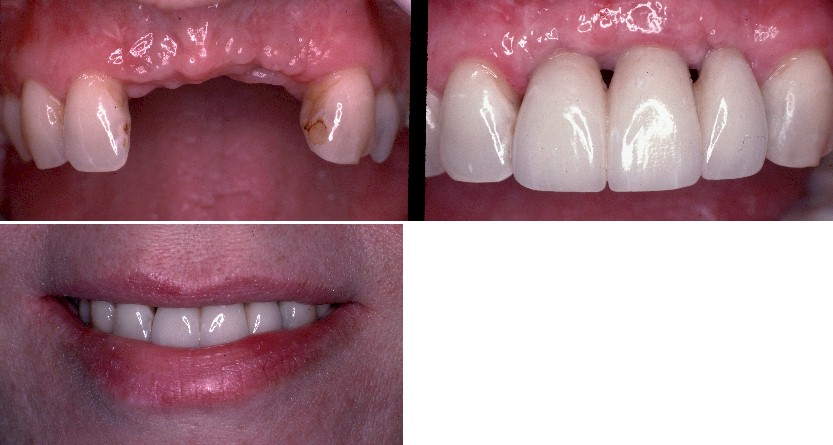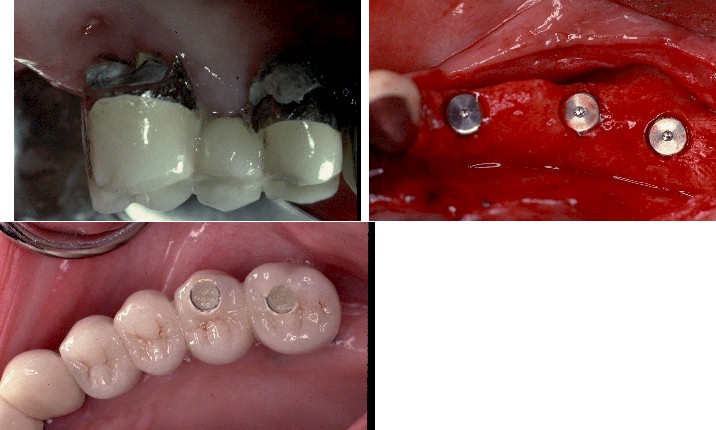Procedures performed in-office
Achieving outcomes of naturally beautiful teeth
SELECT A
PROCEDURE
Tooth Replacement
Adhesive Bridges ⟩
Porcelain to Metal Bridges ⟩
Implants ⟩
Teeth are lost for various reasons, cavities, periodontal disease, trauma, nerve infection to name the most common. In the past it was commonplace for teeth to be extracted (removed). As dental science has advanced, the ability to save teeth has become the norm. In most cases teeth which previously would have been lost can now be saved. The main reasons people still lose teeth today are 1) Lack of Knowledge, 2) Lack of Financial Ability, 3) Lack of Care, 4) Trauma or 5) Cracked Roots.
When teeth are lost a chain of events are put into place which without correction can lead to further loss of teeth and function. Other teeth can shift into the created spaces and chewing forces may shift to other teeth. This can subsequently cause the front teeth to flare out creating unwanted spaces. An altered bite can also cause the facial features to collapse. The more teeth that are lost and not replaced, the greater the odds that wrinkles and lines will form, causing premature aging.
Missing teeth can be replaced with either fixed (not removable) or removable replacements (prostheses). Non-removable or fixed prostheses are usually preferable since they are more similar in function and esthetics than removable prostheses. Fixed bridges have traditionally been made of porcelain fused to a gold alloy and they are still the "Gold Standard". Newer bridges are now available which are made of composite resins with fiberglass substructures, high strength ceramics and hybrid materials. Each of these materials has a time and place and if used selectively can have wonderful results. The main problem with non-metal fixed bridges has been their fracture resistance is poor compared to porcelain fused to metal.
Conventional fixed bridges require that teeth on either side of the missing tooth/teeth are prepared for crowns. The bridge is nothing more than multiple crowns connected together and cemented to the prepared teeth (called abutments). The replaced tooth is called the pontic. Another type of fixed bridge does not rely upon the abutments prepared for crowns for retention, but rather relies upon bonding materials for retention. These are called adhesive bridges or "Maryland Bridges" Originally Maryland bridges were porcelain fused to metal prostheses which were bonded to the backs of the adjacent teeth after minor tooth preparation was completed. While this type of bridge is still common, a non-metalic adhesive bridge has been developed call an "Encore Bridge", which is composed of a fiberglass/composite resin backing which is bonded to the adjacent teeth and a porcelain laminate which is then bonded to the front of the pontic tooth. There are also versions of this which are all processed composite, without the porcelain laminate. This technique has a high success rate in front teeth, but fails more easily in back teeth where the chewing forces increase dramatically.
Another option for replacing missing teeth is Implants. For years physicians have been using implants to replace missing body parts such as hips and shoulders. Today, dentists can use the same techology to replace missing teeth. Dental implants have become a predictable, esthetic alternative to fixed or removable bridgework.
What is an Implant? An implant is an artificial root replacement, usually made from a titanium alloy, which is surgically placed into the bone. During the healing phase, usually 4-6 months, the bone fuses to the implant. Once the implant is fused (osseointegrated), the implant is surgically exposed and a healing cap is placed. Once the gums have healed around this healing cap, a crown, bridge or other device for replacing a tooth/teeth is fabricated. Implant retained teeth can look, feel and function just like the original tooth/teeth they replace. Your doctor can advise you on the possibility of having implants in your situation.










